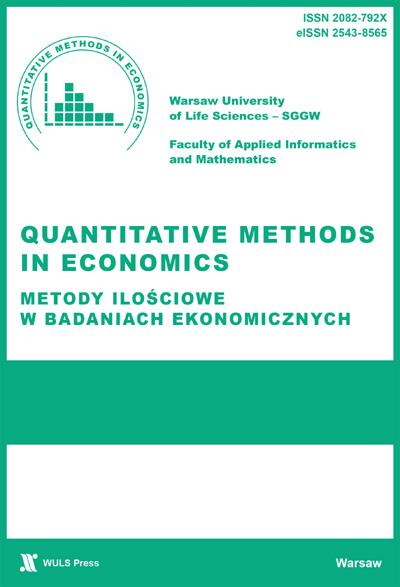THE COMPARISON OF RANKINGS CREATED FOR OPEN-END EQUITY MUTUAL FUNDS WITH APPLICATION OF DIFFERENT EFFECTIVENESS MEASURE
Main Article Content
Abstrakt
The presented work tries to carry out the comparison analysis of eight measures which are used to judge the open-end mutual fund’s management. These are: coefficient of Burke, Sterling, Calmar, Omega, Sortino, Sharpe – Izraelsen, Information Ratio and potential of excess rate of return. The above measures were applied to equity mutual funds operating on polish capital market in 2003-2012 years. The investigations were carried out for three periods: 2003-2012 and for two five years sub-periods. Within which of them the ranking of funds were created to classify them from the most effective to the smallest. In order to answer the question about the influence of singled out effectiveness measures on judgment of portfolio management the Spearman rang coefficients were calculated between rankings created with application of different measures. In this way the detailed information was obtained not only about “the best” and “the worst” mutual funds in different periods but also this information was made dependent on market condition. It is because the division of investigation period on two sub-periods harmonizes with bullish and bearish market on polish stock exchange. From one point this work is some recapitulation of the results obtained by authors in previous investigations but from another point it is some kind of its extension and generalization.
Article Details
Jak cytować
Karpio, A., & Żebrowska-Suchodolska, D. (2013). THE COMPARISON OF RANKINGS CREATED FOR OPEN-END EQUITY MUTUAL FUNDS WITH APPLICATION OF DIFFERENT EFFECTIVENESS MEASURE. Metody Ilościowe W Badaniach Ekonomicznych, 14(1), 202–211. Pobrano z https://qme.sggw.edu.pl/article/view/3589
Statystyki
Downloads
Download data is not yet available.
Rekomendowane teksty
Podobne artykuły
- Sebastian Jarzębowski, PARAMETRIC AND NON-PARAMETRIC EFFICIENCY MEASUREMENT – THE COMPARISON OF RESULTS , Metody Ilościowe w Badaniach Ekonomicznych: Tom 14 Nr 1 (2013)
Możesz również Rozpocznij zaawansowane wyszukiwanie podobieństw dla tego artykułu.
Inne teksty tego samego autora
- Andrzej Karpio, ABOUT A CERTAIN “ANOMALY” IN THE PRICING OF DEBT SECURITIES , Metody Ilościowe w Badaniach Ekonomicznych: Tom 20 Nr 1 (2019)
- Dorota Żebrowska-Suchodolska, THE RISK OF THE POLISH EQUITY FUNDS IN THE YEARS 2004-2018 DETERMINED USING THE VAR AND CVAR MEASURES , Metody Ilościowe w Badaniach Ekonomicznych: Tom 20 Nr 1 (2019)
- Andrzej Karpio, Dorota Żebrowska-Suchodolska, EFEKTYWNOŚĆ INWESTYCYJNA FUNDUSZY EMERYTALNYCH NA TLE FIO STABILNEGO WZROSTU , Metody Ilościowe w Badaniach Ekonomicznych: Tom 15 Nr 4 (2014)
- Andrzej Karpio, Dorota Żebrowska-Suchodolska, THE INFLUENCE OF PENSION FUNDS ON THE POLISH CAPITAL MARKET , Metody Ilościowe w Badaniach Ekonomicznych: Tom 15 Nr 1 (2014)
- Andrzej Karpio, Kilka uwag dotyczących stopy zwrotu w terminie do wykupu , Metody Ilościowe w Badaniach Ekonomicznych: Tom 13 Nr 3 (2012)
- Andrzej Karpio, Dorota Żebrowska-Suchodolska, EFEKTYWNOŚĆ INWESTYCYJNA POLSKICH FUNDUSZY EMERYTALNYCH W OKRESIE ZMIAN ZASAD PRAWNYCH , Metody Ilościowe w Badaniach Ekonomicznych: Tom 17 Nr 3 (2016)
- Andrzej Karpio, Dorota Żebrowska-Suchodolska, STRATA JAKO PODSTAWA OCENY EFEKTYWNOŚCI INWESTYCYJNEJ FIO AKCJI I ZRÓWNOWAŻONYCH , Metody Ilościowe w Badaniach Ekonomicznych: Tom 15 Nr 3 (2014)
Licencja
Publikowane artykuły dostępne są na warunkach Open Access na zasadach licencji Creative Commons CC BY-NC – do celów niekomercyjnych udostępnione materiały mogą być kopiowane, drukowane i rozpowszechniane. Autorzy ponoszą opłatę za opublikowanie artykułu.

